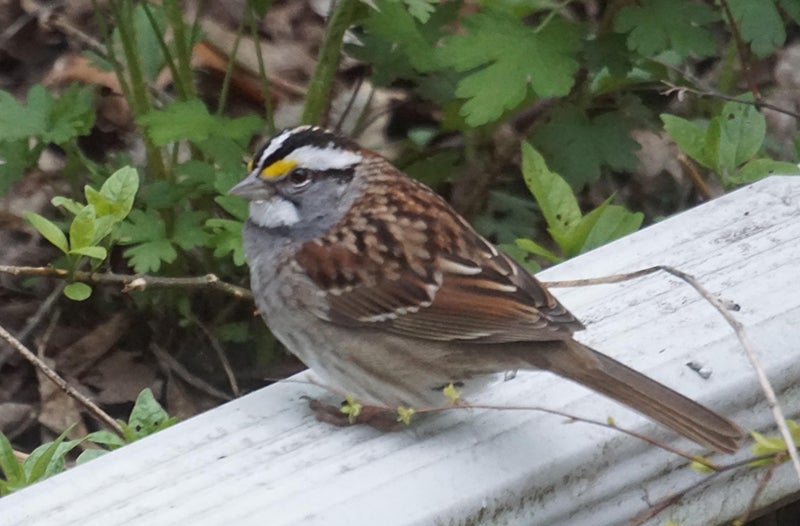Al Batt: How to tell the difference between a viceroy butterfly and a monarch
Published 9:00 am Saturday, September 30, 2017

- White-throated sparrows thrive in a northern climate. Al Batt/Albert Lea Tribune
Al Batt of Hartland is a member of the Albert Lea Audubon Society. Email him at SnoEowl@aol.com.
My neighbor Crandall stops by.
“How are you doing?” I ask.
“Everything is nearly copacetic. I’m exhausted. I’ve been breathing all day. I talked to Denny Duckandcover yesterday. He’s going to run for office. He ran a manure spreader for years, so it’s only natural that he gets into politics. Denny took me duck hunting once. We got up at 2 a.m. and drove to the duck blind. It was pouring rain and cold enough that I could see my breath. We drank lukewarm coffee until one duck flew over. All around the lake, hunters blasted away. The duck kept flying until it was out of sight. It was the only duck we saw all day. Now whenever Denny asks me to go duck hunting with him, I get into the shower. I wear my hunting clothes and turn the shower on so that the water is as cold as it can get. Then when I’m good and soaked and shivering up a storm, I tear up $20 bills. It gives me the same experience as going duck hunting.”
Naturally
I munched on a honeycrisp apple as I watched a combine gnawing through a bean field. It’s my favorite eating appletart, sweet, crispy and juicy. My wife had just bought them along with a bag of SweeTango apples. Honeycrisp is a cross between a macoun and a honeygold apple. SweeTango is a cross between a honeycrisp and a zestar apple.
As I enjoyed the apple, a painted lady butterfly flew very high overhead. It was migrating south on an air current. It was headed to the southwest, maybe Texas or Mexico. I saw more painted ladies this year than I’ve seen in 15 years. I see some painted ladies until the first frost.
Folklore says that for every fog in August, comes a snowfall in the winter. This is unlikely, but I never remember to count the fogs to prove it wrong.
The leaves of the trees provide a pleasing palette. Faith Baldwin wrote, “Autumn burned brightly, a running flame through the mountains, a torch flung to the trees.”
I fall for fall each year.
Duck stamp
Bob Hautman, an artist from Delano, is the winner of the 2017 Federal Duck Stamp Art Contest. Hautman’s acrylic painting of a pair of mallards will be made into the 2018-2019 Federal Migratory Bird Hunting and Conservation Stamp or Duck Stamp, which goes on sale in June 2018. The Federal Duck Stamp sells for $25 and raises nearly $40 million each year to provide funds to conserve and protect wetland habitats in the National Wildlife Refuge System for the benefit of wildlife. This is Hautman’s third Federal Duck Stamp Contest win. His art previously appeared on the 1997-1998 and 2001-2002 Federal Duck Stamps. Hautman’s brothers, Jim and Joe, are also multiple Duck Stamp artists, having each won the contest five times.
Q&A
“Do blue jays migrate?” Some individual jays might migrate south one year, stay north the next winter and then migrate south again the following year. There has been no determination as to why their migration is so complicated.
“How can I tell a viceroy butterfly from a monarch?” It can be difficult. The coloring and pattern of monarch and viceroy wings are nearly identical. However, a viceroy has a black line crossing the postmedian hindwing. Viceroys are smaller than monarchs, although this size difference may be difficult to distinguish. A viceroy has a faster and more erratic flight than the monarch, which floats in a flap, flap and glide pattern. Monarchs are famous for their migration. Viceroys don’t migrate. They overwinter as larvae, rolled up in a leaf of a willow or poplar.
“Why do birds flock together?” There are advantages to flocking. A flock can spot predators quicker. Many eyes enhance foraging efficiency. Food is found faster. A flock is a singles’ scene. It’s a place to find mates. Flocks offer a learning experience. Young birds are schooled by older birds. Flying in flocks can conserve energy. Roosting in flocks provides increased detection of predators and shared body warmth during cold weather.
“Why do mallards sound as if they are laughing?” The quintessential duck’s quack is the sound made by the female mallard. Females often give this call in a series of two to ten quacks that begin loudly and become softer. When courting, she may give a paired form of this quack. The male does not quack. He gives a quieter, rasping, one- or two-noted call. The familiar laughing is from the female mallard and is called the “decrescendo call”. This call can be heard for long distances. A female gives the call when she wants to bring other ducks to her, such as her ducklings.
Thanks for stopping by
“If you woke up breathing, congratulations! You have another chance.” — Andrea Boydston
“The good thing about science is that it’s true whether or not you believe in it.” — Neil deGrasse Tyson
Do good.



